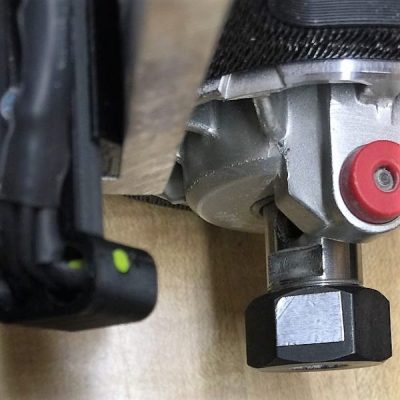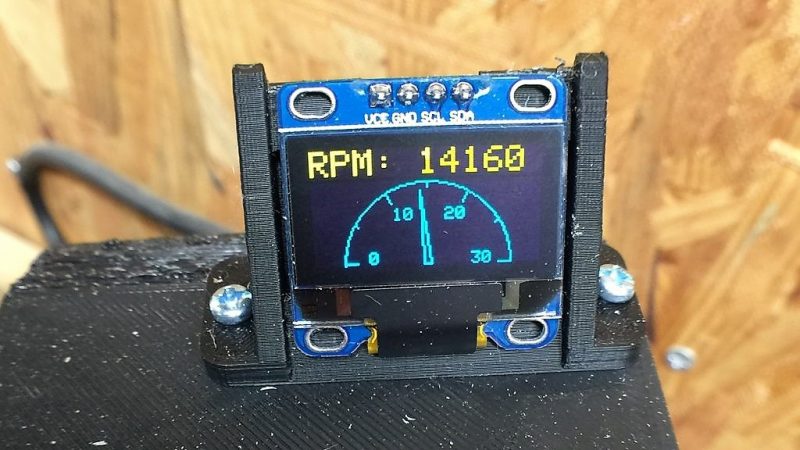With CNC machines, getting the best results depends on knowing how fast your tool is moving relative to the workpiece. But entry-level CNC routers don’t often include a spindle tachometer, forcing the operator to basically guess at the speed. This DIY optical spindle tach aims to fix that, and has a few nice construction tips to boot.
 The CNC router in question is the popular Sienci, and the 3D-printed brackets for the photodiode and LED are somewhat specific for that machine. But [tmbarbour] has included STL files in his exhaustively detailed write-up, so modifying them to fit another machine should be easy. The sensor hangs down just far enough to watch a reflector on one of the flats of the collet nut; we’d worry about the reflector surviving tool changes, but it’s just a piece of shiny tape that’s easily replaced. The sensor feeds into a DIO pin on a Nano, and a small OLED display shows a digital readout along with an analog gauge. The display update speed is decent — not too laggy. Impressive build overall, and we like the idea of using a piece of PLA filament as a rivet to hold the diodes into the sensor arm.
The CNC router in question is the popular Sienci, and the 3D-printed brackets for the photodiode and LED are somewhat specific for that machine. But [tmbarbour] has included STL files in his exhaustively detailed write-up, so modifying them to fit another machine should be easy. The sensor hangs down just far enough to watch a reflector on one of the flats of the collet nut; we’d worry about the reflector surviving tool changes, but it’s just a piece of shiny tape that’s easily replaced. The sensor feeds into a DIO pin on a Nano, and a small OLED display shows a digital readout along with an analog gauge. The display update speed is decent — not too laggy. Impressive build overall, and we like the idea of using a piece of PLA filament as a rivet to hold the diodes into the sensor arm.
Want to measure machine speed but don’t have a 3D printer? No worries — a 2D-printed color-shifting tach can work too.
















He also could have taken a relatively cheap Chinese tachometer and disassembled it, put the diode on a pair of long wires, the display in a preferred spot, and hidden away the rest of the electronics.
Somethings are a learning process and not necessarily a saving money, inventing ways for your self not that much has not been done before.
Good first step with a nice display. Next is to use the tach output and a PID loop to control the spindle speed and close the loop. Getting your speed right is important, /keeping/ it right as it moves through the work, different feed speeds, different pass depths or in things like wood random density changes, is even more so.
Mach3 has that built in, probably linuccnc too. Any opto interrupter will do it, pretty much. I have used the z pulse out of encoders as well as keyence reflective fiber sensors.
I gotta say, that’s a good use of those stoopid 2 color oleds. but that’s probably the only valid use of those top color bands; boggle why they even made such a strange product. all one color makes more sense, but in this case, its the one exception ;)
I think it’s for mobile phones; the yellow shows icons like a battery, signal strength, etc. The blue is the ‘main’ display.
Only, color screens got cheap so quickly, so…why bother, right? Maybe for handheld radios or other sorts of ultra-low-power applications that also for some reason require a GUI? It does seem a little bit strange that they still make them; they don’t cost much less than the all-blue or all-white ones, so I gotta guess it’s not an overstock sort of situation.
Wow, not only do I have most of those parts, I also have an immediate need for this. Great build and nice post. Thanks!
Great Post! Really love to have this. A must-have tool for CNC machining.Thanks for it.